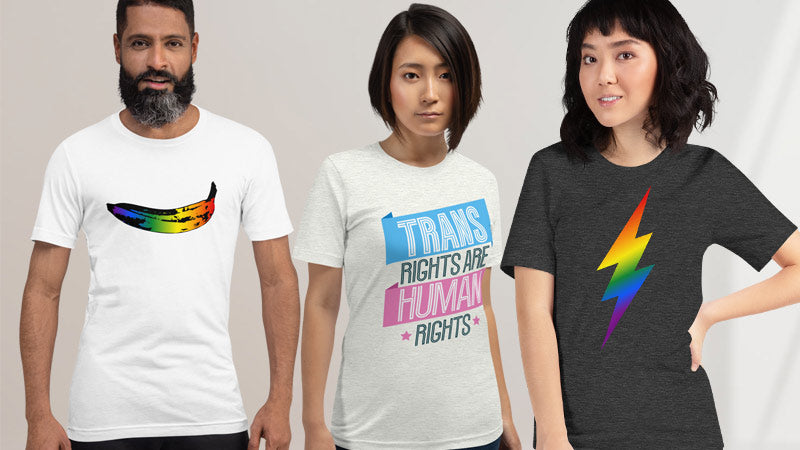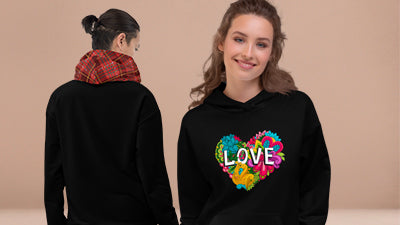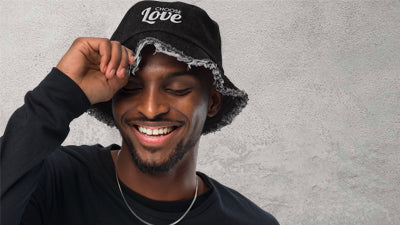Bisexual Awareness Week and Bisexual Visibility Day

When is Bisexual Awareness Week?
Bisexual Awareness Week (#BiWeek) takes place every year from September 16th – 23rd and culminates in Bisexual Visibility Day, which is always on the 23rd and was first celebrated in 1999 by the International Lesbian and Gay Association Conference in Johannesburg, South Africa and has been an annual celebration for the Bisexual community ever since.
What is Bisexual Awareness Week?
Bisexual Awareness Week was founded by GLAAD and BiNet USA to highlight Bisexual people’s specific challenges and promote understanding within both heterosexual and the LGBTQ+ communities. It's is a time for Bisexuals to feel a sense of community and for other LGBTQ+ people and allies to show solidarity. This can be achieved through education and engaging with bi-led events.
It's also a great opportunity for businesses to implement positive changes in their workplaces, to ensure that Bisexual employees feel seen and respected. Bisexual Awareness Week is particularly important to those Bisexuals who may be perceived as straight because they’re currently in a straight-presenting relationship. It is a reminder that there is no one idea of what a Bisexual person can look like, and that their identities should be honoured in the workplace and in society in general.
Corporations can use Bisexual Awareness Week as a time to prioritise diversity and inclusion training through educational events and activities, and to show their Bisexual employees of all genders that their issues matter.
SHOP OUR BISEXUAL COLLECTION view the full collection
What Does Bisexual Mean?
Despite the prefix “bi” meaning two, Bisexuality does not in any way reinforce the gender binary. The definition of Bisexual has evolved over time. Historically, when gender was understood as a binary, Bisexual meant an attraction to both men and women.
But as the concept of gender binary has been consigned to history, Bisexuality is now defined as attraction to more than one sex or gender. For example, Bisexual Resource Center board member Gabrielle Blonder’s definition of Bisexuality is “attracted to genders like mine and genders different from mine.” This inclusive definition validates the existence of those identifying under trans or the non-binary umbrellas.
Non-bi people often confuse Bisexuality with Pansexuality, and many Bi people do use the two terms interchangeably, but Pansexuality is seen as an attraction to people regardless of their gender, whereas Bisexuality is the attraction to multiple genders, and in many cases bi people may have a gender preference.
It is important to respect the history and evolution of the Bisexual identity - which was introduced in the 1970s by activists to distinguish themselves as a group from lesbians and gay men – and that many of these activists were powerful supporters of trans and gender non-conforming people. Language is constantly evolving; the important thing is that Bisexuals and those identifying outside of the gender binary should support each other and co-exist within the LGBTQ+ community.
Bi also became the de facto umbrella term for all identities that meant attraction to more than one gender. Which has caused some of the broadening of the term. But in recent yeras the term Bi+ has become more widely used as the umbrella term. To see all of the sexual orientation terms check our blog on the Types of Sexual Orientation.

Why is Bisexual Awareness Important?
According to a recent Gallup poll, over half of all LGBTQ+ people identify as Bisexual. So the community is huge. And yet there is still so much ignorance of what it means to be Bisexual. So promoting awareness is critical.
Bisexual people face specific problems compared to other groups in the LGBTQ+ community. For example, many people accuse Bisexuals of just “going through a phase,” that they are really gay or straight. One of the worst tropes that Bisexual people have to deal with is that they are being “greedy”, “promiscuous” or that they’ll “always be unfaithful” to their partner. All of these are completely untrue.
It’s an uncomfortable fact that Bisexuals don’t just face discrimination from heterosexual people, but from within the LGBTQ+ community too. Stonewall’s Bi Report shows that bi people often report not feeling welcome in LGBTQ+ spaces. In fact, 43% of bi people have never attended an LGBTQ+ space or event, compared to 29% of gay men and lesbians.
Unlike lesbians and gay men, Bisexual people can experience erasure or straight-washing when in heterosexual-presenting relationships. Bisexual erasure can affect men and women differently, with Bisexual men tending to be perceived as gay, and Bisexual women as straight.
So Bisexual awareness is crucial to help recognize the issues faced and reduce stigma in straight and gay communities alike.
Many people use Bisexual Awareness Week to come out or publicly show their Bisexual pride. But it’s important to note that not every Bisexual or queer person feels comfortable to be open about their identity.
For them, Bisexual Awareness Week can be a useful tool to see widespread support and feel inspired to share their story, or even just see how their friends and family feel about the topic.
In a political moment in which right-wing governments are taking away LGBTQ+ rights, the need for Bisexual Awareness is more palpable than ever.
Five Famous Bi People From History
Frida Kahlo (1907 – 1954)
Frida Kahlo was a Mexican painter known for her self-portraits and magical realist style. Her work has become iconic and beloved around the world. She was a Communist and fought passionately for women’s rights and racial equality. She was open about her romantic and sexual relationships with men and women.
She once said: “Take a lover who looks at you like maybe you are magic.”
David Bowie (1947 – 2016)
David Bowie was an English singer, songwriter and actor. Regarded as one of the most influential musicians of the 20th Century, his diverse genres and glamourous personas thrilled audiences around the world. He was known for his unique, androgynous style, often wearing makeup and flamboyant fabrics.
He once said: “It’s true – I am a Bisexual. But I can’t deny that I’ve used that fact very well. I suppose it’s the best thing that ever happened to me.”
Anne Frank (1929 – 1944)
Anne Frank was a German-born Jewish girl whose chronicle of her time hiding from the Nazis during the Holocaust shed light on one of the darkest periods of history. Her writing has educated and enlightened millions of people worldwide.
Many people don’t know that she was Bisexual. She wrote in her famous diary on Thursday 6th January 1944: “Once when I was spending the night at Jacque's, I could no longer restrain my curiosity about her body, which she'd always hidden from me and which I'd never seen. I asked her whether, as proof of our friendship, we could touch each other's breasts. Jacque refused. I also had a terrible desire to kiss her, which I did. Every time I see a female nude, such as the Venus in my art history book, I go into ecstasy. Sometimes I find them so exquisite I have to struggle to hold back my tears. If only I had a girlfriend!”
Josephine Baker (1906 – 1975)
The first Black woman to star in a major motion picture in 1927, Josephine Baker was an American-born dancer, singer and actress. She spent most of her life in France, particularly in Paris, where she performed burlesque and cabaret. She was a symbol of the Jazz Age and the Roaring Twenties. She served the French Resistance during World War II. She fought against racism in the United States, refusing to perform for segregated audiences.
Her relationships with women are well documented and she enjoyed wearing tuxedos and top hats. She once said: “Try to understand and love each other before it is too late.”
Jean-Michel Basquiat (1960 – 1988)
Jean-Michel Basquiat was an American artist of Haitian and Puerto Rican heritage whose career rose from graffitiing the streets of New York to world-renowned museums and galleries. His paintings are now some of the most valuable in the world. He was close friends and collaborated with Andy Warhol.
One of his girlfriends, Suzanne Mallouk, described his sexuality as “very rich and multichromatic… He was attracted to people for all different reasons. They could be boys, girls, thin, fat, pretty, ugly. It was, I think, driven by intelligence.”
Some Bisexual Icons To Follow On Instagram
Megan Fox, actress
Frank Ocean, singer
Cynthia Erivo, singer and actor
Lady Gaga, singer and actor
Cara Delevingne, actor and model
Tanya Compas, activist and youth worker
Jessamyn Stanley, yoga teacher and activist
AC Dumlao, activist and educator
Keiynan Lonsdale, actor
Kali Uchis, singer
Auli’i Cravalho, actor
Janelle Monáe, singer and actor x
Munroe Bergdorf, DJ and trans activist
How You Can Get Involved in Bisexual Awareness Week
You can find in-person events in your local area, for example talks about Bisexuality, Bisexual themed movie nights or book clubs. You can participate in social media, for example sharing anything from educational content to just fun selfies to show your authentic Bisexual experience.
If you are Bisexual, this week is all about celebrating yourself and the community. If you’re an ally, you can use this time to share enlightening resources and appreciate the Bisexual people in your life. You can uplift Bisexual voices and activism by reposting and retweeting, or showing up to events. You can sign petitions for Bisexual equality and rights.
If you’d like to post about Bi issues on social media use the hashtags #biweek, #BisexualAwarenessWeek and #BAW24.
Make sure your workplace knows about Bisexual Awareness Week. If you can, try and arrange events or talks with Bi+ people or Bi+ advocates, to educate others about these important issues.
You can wear clothing, accessories or pin badges with positive bi messages or pride flags to show your support and start a conversation.
There are lots of other ways that you can support your Bisexual friends, not just this week, but every day.
- Learn about Bisexual identities by reading the books listed above or by seeking out online resources that tell you first hand accounts of the challenges Bi people face.
- It’s important to uplift the voices of Bisexual people, so talk to Bi friends or acquaintances and listen properly to their stories about their lived experiences.
- Follow, like, and repost the Bisexual people you encounter on social media.
- At work make sure you support Bi colleagues and vocally advocate for Bisexual supportive policies and practices.
Some Great Books by Bisexual Authors
Bi: Notes on a Bisexual Revolution
by Shiri Eisner
Bi: The Hidden Culture, History, and Science of Bisexuality
by Julia Shaw
The Bi-ble: Essays and Narratives About Bisexuality
edited by Lauren Nickodemus and Ellen Desmond
Bi the Way: The Bisexual Guide to Life
by Lois Shearing
Bisexual Men Exist
by Vaneet Menta
The B Word: Bisexuality in Contemporary Film and Television
by Maria San Filippo
Getting Bi: Voices of Bisexuals Around the World
edited by Robyn Ochs and Sarah E. Rowley

Bisexual Themed Podcasts
Bisexual Pride Flag
Created in 1998 by a group led by Bisexual activist Michael Page. In the original meaning the pink stripe was intended to represent same sex attraction, the blue stripe was attraction to the opposite sex and the purple stripe was a combination of both colours and so is an attraction to both sexes. However current interpretations have changed and the pink is now seen as an attraction to female or femme people, purple to non binary people and blue to male or masculine people. The Bi+ identity was also created to move away from the idea that Bisexuality focussed on the binaries.
















